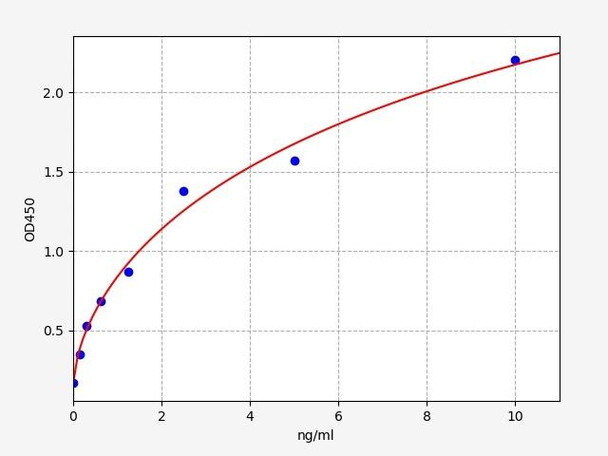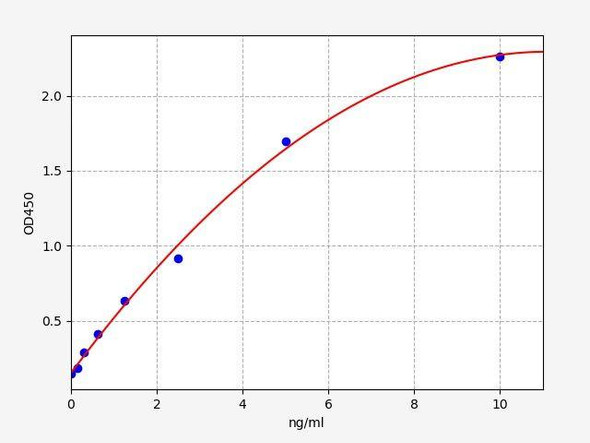Rat ARNT / HIF-1-beta ELISA Kit (RTFI01246)
- SKU:
- RTFI01246
- Product Type:
- ELISA Kit
- Size:
- 96 Assays
- Uniprot:
- P41739
- Sensitivity:
- 0.094ng/ml
- Range:
- 0.156-10ng/ml
- ELISA Type:
- Sandwich
- Synonyms:
- Aryl hydrocarbon receptor nuclear translocator, Dioxin receptor, nuclear translocator
- Reactivity:
- Rat
- Research Area:
- Epigenetics and Nuclear Signaling
Description
Rat ARNT/HIF-1-beta ELISA Kit
The Rat ARNT (HIF-1 Beta) ELISA Kit is a powerful tool for detecting levels of ARNT (Aryl hydrocarbon receptor nuclear translocator) in rat samples, including serum, plasma, and cell culture supernatants. This kit is known for its high precision and accuracy, providing consistent and reliable results for various research applications.ARNT is a key protein that plays a critical role in regulating the response to hypoxia and is a crucial component of the HIF-1 (Hypoxia-inducible factor 1) complex. Dysregulation of ARNT has been linked to various diseases and conditions, including cancer, metabolic disorders, and cardiovascular diseases, making it a valuable biomarker for studying such conditions and potential therapeutic interventions.
With its advanced technology and proven performance, the Rat ARNT (HIF-1 Beta) ELISA Kit offers researchers a dependable tool for investigating the role of ARNT in physiological and pathological processes, ultimately advancing our understanding of complex diseases and facilitating the development of new treatment strategies.
| Product Name: | Rat ARNT/HIF-1-beta (Hypoxia-inducible factor 1-beta) ELISA Kit |
| Product Code: | RTFI01246 |
| Size: | 96 Assays |
| Target: | Rat ARNT/HIF-1-beta |
| Alias: | Aryl hydrocarbon receptor nuclear translocator, Dioxin receptor, nuclear translocator |
| Reactivity: | Rat |
| Detection Method: | Sandwich ELISA, Double Antibody |
| Sensitivity: | 0.094ng/ml |
| Range: | 0.156-10ng/ml |
| Storage: | 4°C for 6 months |
| Note: | For Research Use Only |
| Recovery: | Matrices listed below were spiked with certain level of Rat ARNT/HIF-1-beta and the recovery rates were calculated by comparing the measured value to the expected amount of Rat ARNT/HIF-1-beta in samples. | ||||||||||||||||
| |||||||||||||||||
| Linearity: | The linearity of the kit was assayed by testing samples spiked with appropriate concentration of Rat ARNT/HIF-1-beta and their serial dilutions. The results were demonstrated by the percentage of calculated concentration to the expected. | ||||||||||||||||
| |||||||||||||||||
| Intra-Assay: | CV <8% | ||||||||||||||||
| Inter-Assay: | CV <10% |
| Uniprot: | P41739 |
| UniProt Protein Function: | ARNT: a bHLH transcription factor that requires dimerization with another bHLH protein for efficient DNA binding. A binding partner for the Ah (dioxin) nuclear receptor. Required for the ligand-binding subunit to translocate from the cytosol to the nucleus after ligand binding. The complex then initiates transcription of genes involved in the activation of PAH procarcinogens. A binding partner for HIF1A or HIF2A, transcription factors that regulates transcription from RNA polymerase II promoter in the adaptive response to hypoxia and oxidative stress. This complex activates target genes that limit oxygen consumption. HIF-1alpha may have nontranscriptional activities that inhibit DNA replication and cell proliferation when oxygen becomes scarce. Forms heterodimers with other bHLH proteins. Interacts with TACC3. Three isoforms of the human protein are produced by alternative splicing. |
| UniProt Protein Details: | Protein type:DNA-binding; Transcription factor; Nuclear receptor; Motility/polarity/chemotaxis Cellular Component: cytoplasm; nucleus; transcription factor complex Molecular Function:aryl hydrocarbon receptor activity; aryl hydrocarbon receptor binding; DNA binding; protein binding; protein dimerization activity; protein heterodimerization activity; RNA polymerase II transcription factor activity, enhancer binding; sequence-specific DNA binding; transcription coactivator activity; transcription factor activity; transcription factor binding Biological Process: cell differentiation; embryonic placenta development; intracellular receptor-mediated signaling pathway; positive regulation of hormone biosynthetic process; positive regulation of protein sumoylation; positive regulation of transcription from RNA polymerase II promoter; positive regulation of transcription, DNA-dependent; regulation of transcription from RNA polymerase II promoter in response to oxidative stress; regulation of transcription, DNA-dependent; response to hypoxia; response to toxin; transcription, DNA-dependent |
| NCBI Summary: | may act as a transcription factor; mediates dioxin toxicity [RGD, Feb 2006] |
| UniProt Code: | P41739 |
| NCBI GenInfo Identifier: | 7549744 |
| NCBI Gene ID: | 25242 |
| NCBI Accession: | NP_036912 |
| UniProt Related Accession: | P41739 |
| Molecular Weight: | 88kDa |
| NCBI Full Name: | aryl hydrocarbon receptor nuclear translocator |
| NCBI Synonym Full Names: | aryl hydrocarbon receptor nuclear translocator |
| NCBI Official Symbol: | Arnt |
| NCBI Official Synonym Symbols: | Arnt1 |
| NCBI Protein Information: | aryl hydrocarbon receptor nuclear translocator |
| UniProt Protein Name: | Aryl hydrocarbon receptor nuclear translocator |
| UniProt Synonym Protein Names: | Dioxin receptor, nuclear translocator; Hypoxia-inducible factor 1-beta; HIF-1-beta; HIF1-beta |
| Protein Family: | Aryl hydrocarbon receptor nuclear translocator |
| UniProt Gene Name: | Arnt |
| UniProt Entry Name: | ARNT_RAT |
| Step | Procedure |
| 1. | Set standard, test sample and control (zero) wells on the pre-coated plate respectively, and then, record their positions. It is recommended to measure each standard and sample in duplicate. Wash plate 2 times before adding standard, sample and control (zero) wells! |
| 2. | Aliquot 0.1ml standard solutions into the standard wells. |
| 3. | Add 0.1 ml of Sample / Standard dilution buffer into the control (zero) well. |
| 4. | Add 0.1 ml of properly diluted sample ( Human serum, plasma, tissue homogenates and other biological fluids.) into test sample wells. |
| 5. | Seal the plate with a cover and incubate at 37°C for 90 min. |
| 6. | Remove the cover and discard the plate content, clap the plate on the absorbent filter papers or other absorbent material. Do NOT let the wells completely dry at any time. Wash plate X2. |
| 7. | Add 0.1 ml of Biotin- detection antibody working solution into the above wells (standard, test sample & zero wells). Add the solution at the bottom of each well without touching the side wall. |
| 8. | Seal the plate with a cover and incubate at 37°C for 60 min. |
| 9. | Remove the cover, and wash plate 3 times with Wash buffer. Let wash buffer rest in wells for 1 min between each wash. |
| 10. | Add 0.1 ml of SABC working solution into each well, cover the plate and incubate at 37°C for 30 min. |
| 11. | Remove the cover and wash plate 5 times with Wash buffer, and each time let the wash buffer stay in the wells for 1-2 min. |
| 12. | Add 90 µL of TMB substrate into each well, cover the plate and incubate at 37°C in dark within 10-20 min. (Note: This incubation time is for reference use only, the optimal time should be determined by end user.) And the shades of blue can be seen in the first 3-4 wells (with most concentrated standard solutions), the other wells show no obvious color. |
| 13. | Add 50 µL of Stop solution into each well and mix thoroughly. The color changes into yellow immediately. |
| 14. | Read the O.D. absorbance at 450 nm in a microplate reader immediately after adding the stop solution. |
When carrying out an ELISA assay it is important to prepare your samples in order to achieve the best possible results. Below we have a list of procedures for the preparation of samples for different sample types.
| Sample Type | Protocol |
| Serum: | If using serum separator tubes, allow samples to clot for 30 minutes at room temperature. Centrifuge for 10 minutes at 1,000x g. Collect the serum fraction and assay promptly or aliquot and store the samples at -80°C. Avoid multiple freeze-thaw cycles. If serum separator tubes are not being used, allow samples to clotovernight at 2-8°C. Centrifuge for 10 minutes at 1,000x g. Removeserum and assay promptly or aliquot and store the samples at-80°C. Avoid multiple freeze-thaw cycles. |
| Plasma: | Collect plasma using EDTA or heparin as an anti-coagulant. Centrifuge samples at 4°C for 15 mins at 1000 × g within 30 mins of collection. Collect the plasma fraction and assay promptly or aliquot and store the samples at -80°C. Avoid multiple freeze-thaw cycles.Note: Over haemolysed samples are not suitable for use with this kit. |
| Urine & Cerebrospinal Fluid: | Collect the urine (mid-stream) in a sterile container, centrifuge for 20 mins at 2000-3000 rpm. Remove supernatant and assay immediately. If any precipitation is detected, repeat the centrifugation step. A similar protocol can be used for cerebrospinal fluid. |
| Cell Culture Supernatant: | Collect the cell culture media by pipette, followed by centrifugation at 4°C for 20 mins at 1500 rpm. Collect the clear supernatant and assay immediately. |
| Cell Lysates: | Solubilize cells in lysis buffer and allow to sit on ice for 30 minutes. Centrifuge tubes at 14,000 x g for 5 minutes to remove insoluble material. Aliquot the supernatant into a new tube and discard the remaining whole cell extract. Quantify total protein concentration using a total protein assay. Assay immediately or aliquot and store at ≤ -20°C. |
| Tissue Homogenates: | The preparation of tissue homogenates will vary depending upon tissue type. Rinse tissue with 1X PBS to remove excess blood & homogenizein 20ml of 1X PBS (including protease inhibitors) and store overnight at ≤ -20°C. Two freeze-thaw cycles are required to break the cell membranes. To further disrupt the cell membranes you can sonicate the samples. Centrifuge homogenates for 5 mins at 5000xg. Remove the supernatant and assay immediately or aliquot and store at -20°C or-80°C. |
| Tissue Lysates: | Rinse tissue with PBS, cut into 1-2 mm pieces, and homogenize with a tissue homogenizer in PBS. Add an equal volume of RIPA buffer containing protease inhibitors and lyse tissues at room temperature for 30 minutes with gentle agitation. Centrifuge to remove debris. Quantify total protein concentration using a total protein assay. Assay immediately or aliquot and store at ≤ -20 °C. |
| Breast Milk: | Collect milk samples and centrifuge at 10,000 x g for 60 min at 4°C. Aliquot the supernatant and assay. For long term use, store samples at -80°C. Minimize freeze/thaw cycles. |






